MCSA Administering Microsoft SQL Server 2012/2014 Databases v1.0
Question 1
You administer a Microsoft SQL Server 2012 database.
You configure Transparent Data Encryption (TDE) on the Orders database by using the following statements:

You attempt to restore the Orders database and the restore fails. You copy the encryption file to the original location.
A hardware failure occurs and so a new server must be installed and configured.
After installing SQL Server to the new server, you restore the Orders database and copy the encryption files to their original location. However, you are unable to access the database.
You need to be able to restore the database.
Which Transact-SQL statement should you use before attempting the restore?
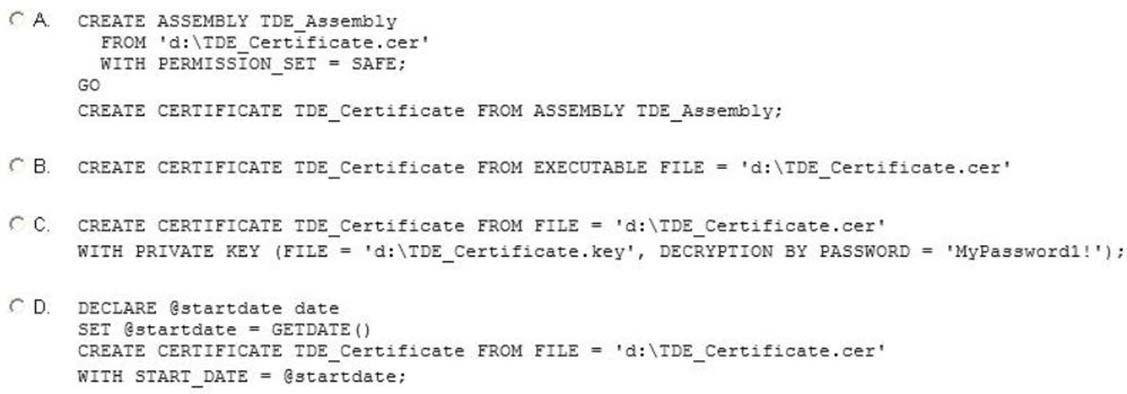
- A. Option A
- B. Option B
- C. Option C
- D. Option D
Answer : C
Explanation:
To create a database protected by transparent data encryption
The following procedures show you have to create a database protected by TDE using SQL Server Management Studio and by using Transact-SQL.
Using SQL Server Management Studio
1. Create a database master key and certificate in the master database.
2. Create a backup of the server certificate in the master database.
Etc.
In transact sql:
-- Create a database master key and a certificate in the master database.
USE master ;
GO -
CREATE MASTER KEY ENCRYPTION BY PASSWORD = '*rt@40(FL&dasl1';
GO -
CREATE CERTIFICATE TestSQLServerCert
WITH SUBJECT = 'Certificate to protect TDE key'
GO -
-- Create a backup of the server certificate in the master database.
-- The following code stores the backup of the certificate and the private key file in the default data location for this instance of SQL Server
-- (C:\Program Files\Microsoft SQL Server\MSSQL13.MSSQLSERVER\MSSQL\DATA).
BACKUP CERTIFICATE TestSQLServerCert
TO FILE = 'TestSQLServerCert'
WITH PRIVATE KEY -
(
FILE = 'SQLPrivateKeyFile',
ENCRYPTION BY PASSWORD = '*rt@40(FL&dasl1'
);
GO -
Etc.
'
References:
https://docs.microsoft.com/en-us/sql/relational-databases/security/encryption/move-a-tde-protected-database-to-another-sql-server
Question 2
DRAG DROP -
You administer a Microsoft SQL Server 2012 server that has multiple databases.
You need to ensure that users are unable to create stored procedures that begin with sp_.
Which three actions should you perform in sequence? (To answer, move the appropriate actions from the list of actions to the answer area and arrange them in the correct order.)
Select and Place:
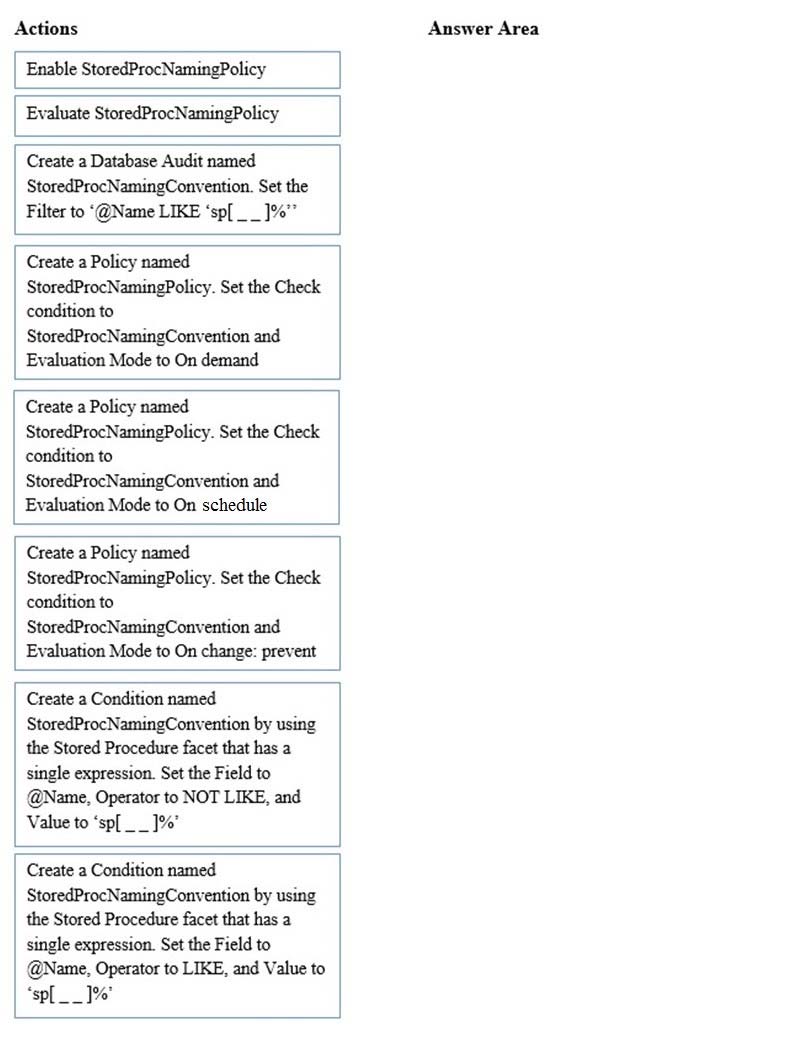
Answer : 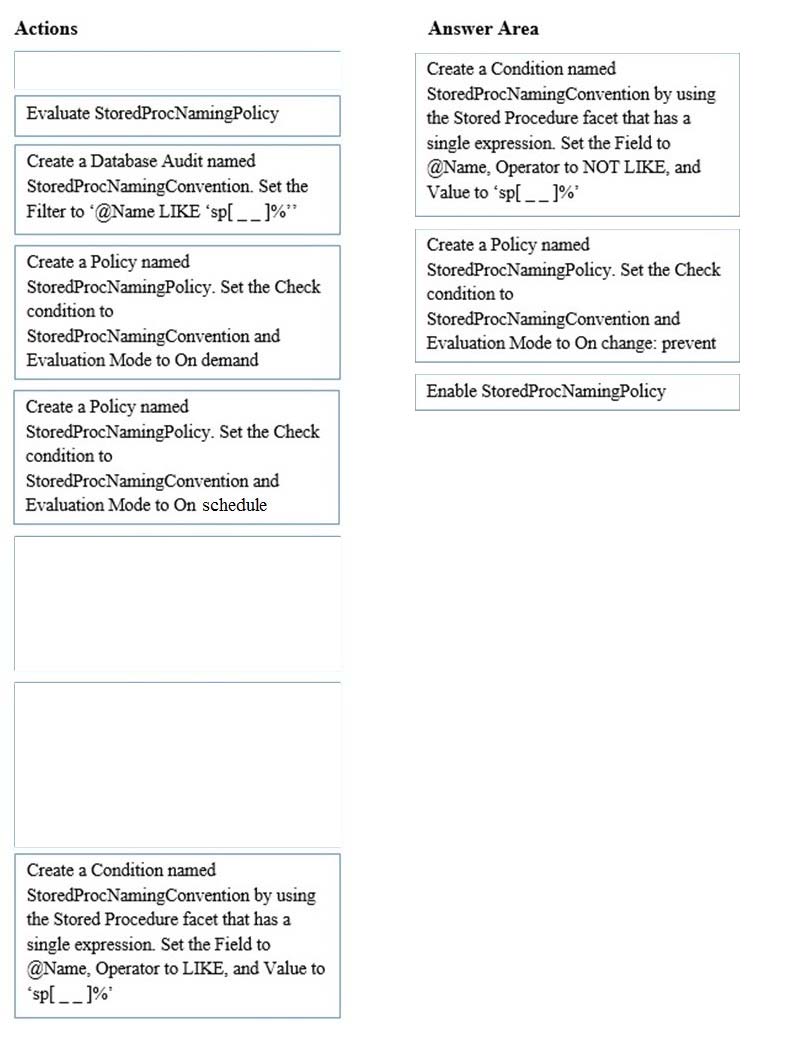
Explanation:
Step 1: Create a Condition named StoredProcNamingConvention by using the Stored Procedure facet that has a single expression. Set the Field to @Name,
Operator to NOT LIKE, and Value to 'sp[_]%'.
Step 2: Create a Policy named StoredProcNamingPolicy Set the Check condition to StoredProcNamingConvention and Evaluation Mode to On Change: Prevent
Step 3: Enable StoredProcNamingPolicy
Policies are created and managed by using Management Studio. The process includes the following steps:
1. Select a Policy-Based Management facet that contains the properties to be configured.
2. Define a condition that specifies the state of a management facet.
3. Define a policy that contains the condition, additional conditions that filter the target sets, and the evaluation mode.
4. Check whether an instance of SQL Server is in compliance with the policy.
Evaluation modes -
There are four evaluation modes, three of which can be automated:
-> On demand. This mode evaluates the policy when directly specified by the user.
-> On change: prevent. This automated mode uses DDL triggers to prevent policy violations.
Important:
If the nested triggers server configuration option is disabled, On change: prevent will not work correctly. Policy-Based Management relies on DDL triggers to detect and roll back DDL operations that do not comply with policies that use this evaluation mode. Removing the Policy-Based Management DDL triggers or disabling nest triggers, will cause this evaluation mode to fail or perform unexpectedly.
-> On change: log only. This automated mode uses event notification to evaluate a policy when a relevant change is made.
-> On schedule. This automated mode uses a SQL Server Agent job to periodically evaluate a policy.
Reference:
http://msdn.microsoft.com/en-us/library/bb510667.aspx
Question 3
You administer a Microsoft SQL Server database.
You provide temporary securityadmin access to User1 to the database server.
You need to know if User1 adds logins to securityadmin.
Which server-level audit action group should you use?
- A. SERVER_STATE_CHANGE_GROUP
- B. SERVER_PRINCIPAL_IMPERSONATION_GROUP
- C. SUCCESSFUL_LOGIN_GROUP
- D. SERVER_ROLE_MEMBER_CHANGE_GROUP
- E. DATABASE_ROLE_MEMBER_CHANGE_GROUP
- F. SERVER_OBJECT_CHANGE_GROUP
- G. SERVER_PERMISSION_CHANGE_GROUP D
Answer : Explanation
Explanation:
The SERVER_ROLE_MEMBER_CHANGE_GROUP event is raised whenever a login is added or removed from a fixed server role. This event is raised for the sp_addsrvrolemember and sp_dropsrvrolemember stored procedures. Equivalent to the Audit Add Login to Server Role Event Class.
Incorrect Answers:
A. The SERVER_STATE_CHANGE_GROUP event is raised when the SQL Server service state is modified. Equivalent to the Audit Server Starts and Stops
Event Class.
B. The SERVER_PRINCIPAL_IMPERSONATION_GROUP event is raised when there is an impersonation within server scope, such as EXECUTE AS <login>.
Equivalent to the Audit Server Principal Impersonation Event Class.
C. The SUCCESSFUL_LOGIN_GROUP Indicates that a principal has successfully logged in to SQL Server. Events in this class are raised by new connections or by connections that are reused from a connection pool. Equivalent to the Audit Login Event Class.
References:
http://technet.microsoft.com/en-us/library/cc280663.aspx
Question 4
You administer a Microsoft SQL Server 2012 instance.
You need to stop a blocking process that has an SPID of 64 without stopping other processes
What should you do?
- A. Execute the following Transact-SQL statement: EXECUTE sp_KillSPID 64
- B. Restart the SQL Server service.
- C. Execute the following Transact-SQL statement: KILL 64
- D. Execute the following Transact-SQL statement: ALTER SESSION KILL '64'
Answer : C
Reference:
http://msdn.microsoft.com/en-us/library/ms173730.aspx
Question 5
DRAG DROP -
You administer a Microsoft SQL Server database server.
A variety of issues occur from time to time in the production environment. You need to identify the appropriate tool for each issue.
Which tool or tools should you use? (To answer, drag the appropriate tool or tools to the correct issue or issues in the answer area. Each tool may be used once, more than once, or not at all. You may need to drag the split bar between panes or scroll to view content.)
Select and Place:
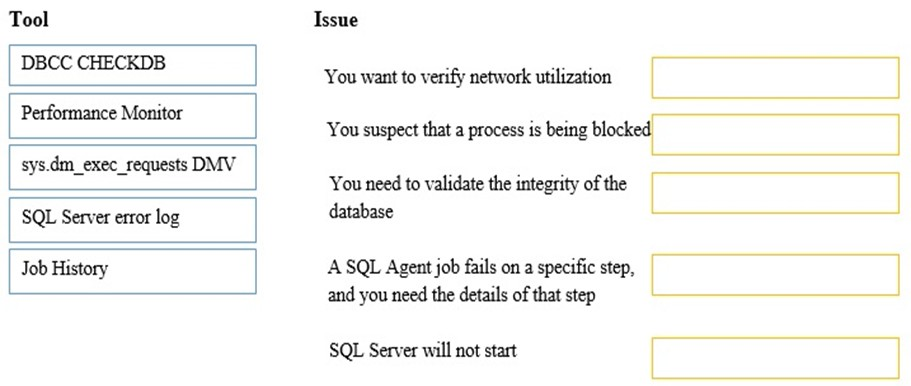
Answer : 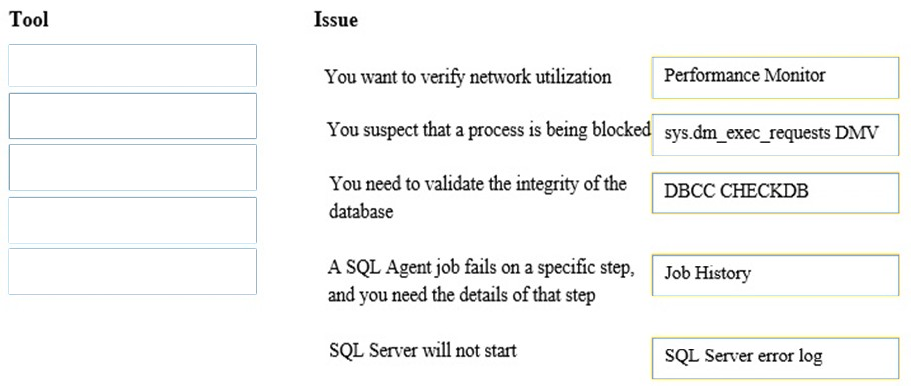
Question 6
You administer a Microsoft SQL Server database.
Users report that an application that accesses the database displays an error, but the error does not provide meaningful information. No entries are found in the
SQL Server log or Windows event logs related to the error.
You need to identify the root cause of the issue by retrieving the error message.
What should you do?
- A. Flag all stored procedures for recompilation by using sp_recompile.
- B. Create an Extended Events session by using the sqlserver.error_reported event.
- C. Create a Performance Monitor session to capture the SQLServer:SQL Errors object.
- D. Create a SQL Profiler session to capture all ErrorLog and EventLog events.
Answer : B
Explanation:
Event sqlserver.error_reported: This event gets fired every time that an error happens in the server
Reference:
http://msdn.microsoft.com/en-us/library/bb630282.aspx
Question 7
You administer a Microsoft SQL Server database server. One of the databases on the server supports a highly active OLTP application.
Users report abnormally long wait times when they submit data into the application.
You need to identify which queries are taking longer than 1 second to run over an extended period of time.
What should you do?
- A. use SQL Profiler to trace all queries that are processing on the server. Filter queries that have a Duration value of more than 1,000.
- B. Use sp_configure to set a value for blocked process threshold. Create an extended event session.
- C. Use the Job Activity monitor to review all processes that are actively running. Review the Job History to find out the duration of each step.
- D. Run the sp_who command from a query window.
- E. Run the DBCC TRACEON 1222 command from a query window and review the SQL Server event log. A
Answer : Explanation
Explanation:
Use SQL Profiler to trace all queries that are processing on the server. Filter queries that have a Duration value of more than 1,000.
Incorrect:
Not B: The SQL Server lock monitor is responsible for implementing the logic to detect a blocking scenario if the "˜blocked process threshold"™ value is greater than
0. However, the lock monitor only wakes up every 5 seconds to detect this condition (it is also looking for other conditions such as deadlocks). Therefore, if you set a "˜blocked process threshold"™ value to 1, it will not detect a process that has been blocking for 1 second. The minimum time it can detect a blocked process is 5 seconds.
Not E: The Traceflag 1222 Shows Deadlocks, not the Duration of an query.
References:
https://docs.microsoft.com/en-us/sql/tools/sql-server-profiler/sql-server-profiler
Question 8
DRAG DROP -
You administer a Microsoft SQL Server database that is used by an application.
Users of the application report performance issues.
You need to choose the appropriate tool for performance-tuning of SQL Server databases.
Which tool or tools should you use? (To answer, drag the appropriate tool or tools to their corresponding task or tasks in the answer area. Each tool may be used once, more than once, or not at all. You may need to drag the split bar between panes or scroll to view content.)
Select and Place:
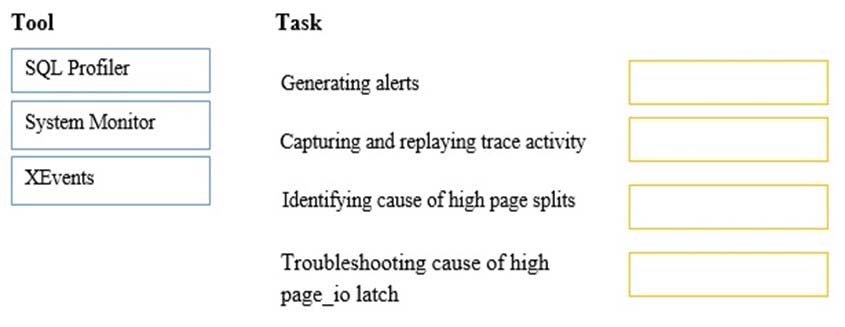
Answer : 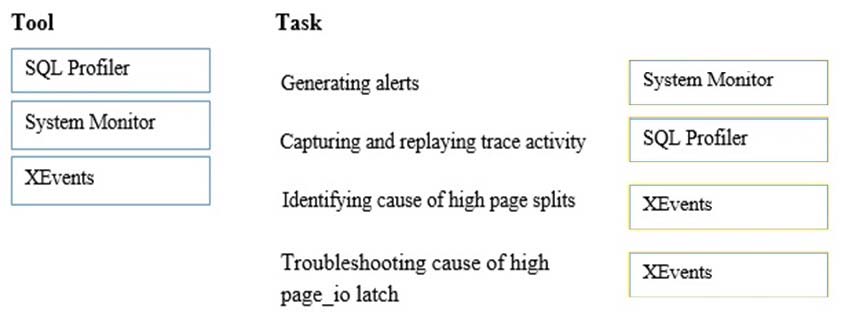
References:
http://msdn.microsoft.com/en-us/library/bb630282.aspx
http://msdn.microsoft.com/en-us/library/ms191246.aspx
http://msdn.microsoft.com/en-us/library/ms181091.aspx
Question 9
You administer a Microsoft SQL Server database.
You need to ensure that the size of the transaction log file does not exceed 2 GB.
What should you do?
- A. Execute sp_configure 'max log size', 2G.
- B. Use the ALTER DATABASE...SET LOGFILE command along with the maxsize parameter.
- C. In SQL Server Management Studio, right-click the instance and select Database Settings. Set the maximum size of the file for the transaction log.
- D. In SQL Server Management Studio, right-click the database, select Properties, and then click Files. Open the Transaction log Autogrowth window and set the maximum size of the file.
- E. Use the ALTER DATABASE"¦AUTO_SHRINK command along with the On parameter.
Answer : D
Question 10
You administer a Microsoft SQL Server server. The MSSQLSERVER service uses a domain account named CONTOSO\SQLService.
You plan to configure Instant File Initialization.
You need to ensure that Data File Autogrow operations use Instant File Initialization.
Which two actions should you perform? Each correct answer presents part of the solution.
- A. Restart the SQL Server Agent Service.
- B. Disable snapshot isolation.
- C. Restart the SQL Server Service.
- D. Add the CONTOSO\SQLService account to the Perform Volume Maintenance Tasks local security policy.
- E. Add the CONTOSO\SQLService account to the Server Operators fixed server role.
- F. Enable snapshot isolation.
Answer : CD
Explanation:
How To Enable Instant File Initialization
1. Open Local Security Policy and go to Local Policies --> User Rights Assignment.
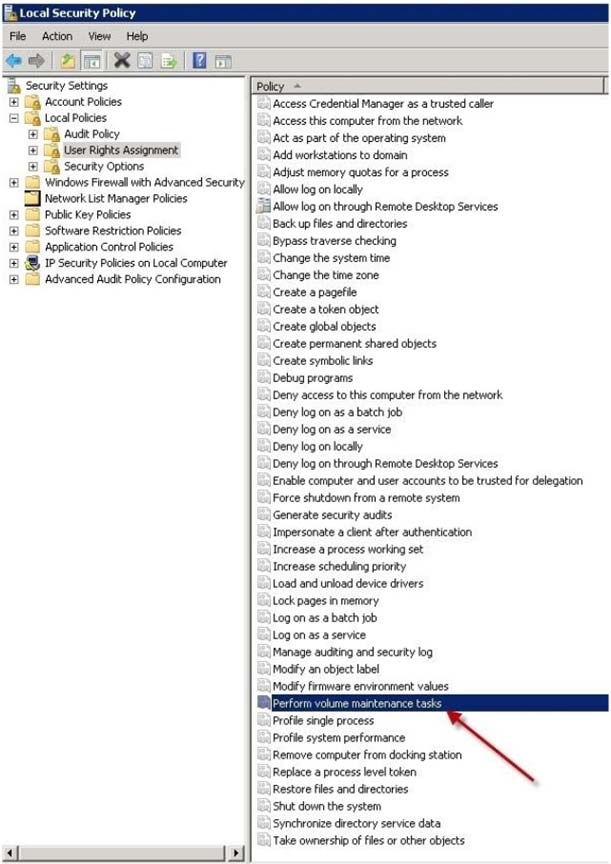
2. Double click Perform Volume Maintenance Tasks and add your SQL Server database engine service account.
3. Restart the SQL Server service using SQL Server Configuration Manager and this setting should now be enabled.
References:
http://msdn.microsoft.com/en-us/library/ms175935.aspx
http://www.mssqltips.com/sqlservertip/2752/effect-of-instant-file-initialization-within-sql-server/
Question 11
DRAG DROP -
You administer a Microsoft SQL Server instance. You use a two-node SQL Server failover cluster. Node B is primary, and Node A is secondary.
You need to install a security patch on both nodes.
You need to ensure that the following requirements are met:
-> Both nodes receive the update.
-> Downtime is minimized.
-> No data is lost.
Which three actions should you perform in sequence? (To answer, move the appropriate actions from the list of actions to the answer area and arrange them in the correct order.)
Select and Place:
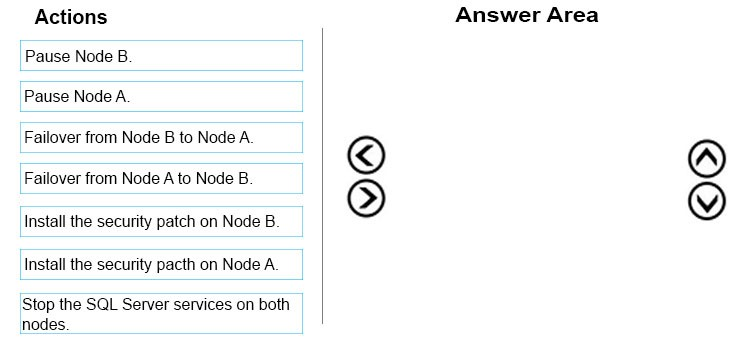
Answer : 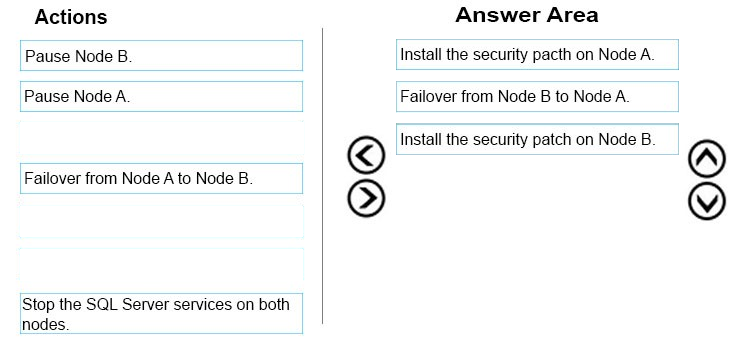
Explanation:
Step 1: Install the security patch on Node A.
Execute the SQL Server Service Pack package at the first passive node. The passive node in this scenario is Node A.
Do not start with Node B: If you update a SQL Server failover cluster instance on an active node, SQL Server services will be stopped. This causes SQL Server downtime.
Step 2: is Failover from Node B to Node A
Failover from Active to Passive Node.
Step 3: Install the security patch on Node B
Note: Starting with the update to Microsoft SQL Server 2012 Service Pack 1, customers with SQL Server 2012 failover cluster instances can greatly benefit from the fully automated update process provided by Cluster-Aware Updating (CAU).
CAU causes minimal down time for SQL Server 2012 client connectivity. While the primary node is being updated, the SQL Server clustered role (also called the resource group) goes through two failovers. The first failover happens before updating the primary node when CAU brings the original primary node into maintenance mode. During the update process on the original primary node, the SQL clustered role is temporarily brought online on a new primary node. The second failover happens once the update process is complete on the original primary node, and CAU fails back the SQL Server clustered role to the original primary node and brings it online.
References:
https://stevethompsonmvp.wordpress.com/2014/12/29/installing-a-service-pack-for-sql-server-cluster/ https://support.microsoft.com/am-et/help/958734/sql-server-failover-cluster-rolling-patch-and-service-pack-process
Question 12
You administer a Microsoft SQL Server 2012 database.
The database contains a Product table created by using the following definition:
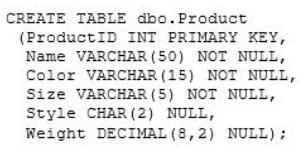
You need to ensure that the minimum amount of disk space is used to store the data in the Product table.
What should you do?
- A. Convert all indexes to Column Store indexes.
- B. Implement Unicode Compression.
- C. Implement row-level compression.
- D. Implement page-level compression.
Answer : D
References:
http://msdn.microsoft.com/en-us/library/cc280449.aspx
http://msdn.microsoft.com/en-us/library/cc280464.aspx
http://msdn.microsoft.com/en-us/library/cc280576.aspx
http://msdn.microsoft.com/en-us/library/ee240835.aspx
Question 13
You administer a Microsoft SQL Server 2012 instance. After a routine shutdown, the drive that contains tempdb fails.
You need to be able to start the SQL Server.
What should you do?
- A. Modify tempdb location in startup parameters.
- B. Start SQL Server in minimal configuration mode.
- C. Start SQL Server in single-user mode.
- D. Configure SQL Server to bypass Windows application logging.
Answer : B
References:
http://msdn.microsoft.com/en-us/library/ms186400.aspx
http://msdn.microsoft.com/en-us/library/ms345408.aspx
Question 14
You administer a single server that contains a Microsoft SQL Server 2012 default instance.
You plan to install a new application that requires the deployment of a database on the server. The application login requires sysadmin permissions.
You need to ensure that the application login is unable to access other production databases.
What should you do?
- A. Use the SQL Server default instance and configure an affinity mask.
- B. Install a new named SQL Server instance on the server.
- C. Use the SQL Server default instance and enable Contained Databases.
- D. Install a new default SQL Server instance on the server.
Answer : B
Question 15
You administer a Microsoft SQL Server 2012 Enterprise Edition server that uses 64 cores.
You discover performance issues when large amounts of data are written to tables under heavy system load.
You need to limit the number of cores that handle I/O.
What should you configure?
- A. Processor affinity
- B. Lightweight pooling
- C. Max worker threads
- D. I/O affinity
Answer : D
Reference:
http://msdn.microsoft.com/en-us/library/ms189629.aspx